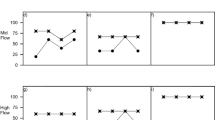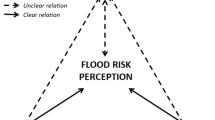Abstract
In this paper, a copula-based methodology is presented for probabilistic assessment of flood risks and investigated the performance of trivariate copulas in modeling dependence structure of flood properties. The flood is a multi-attribute natural hazard and is characterized by mutually correlated flood properties peak flow, volume, and duration of flood hydrograph. For assessing flood risk, many studies have used bivariate analysis, but a more effective assessment can be possible considering all three mutually correlated flood properties simultaneously. This study adopts trivariate copulas for multivariate analysis of flood risks, and applied to a case study of flood flows of Delaware River basin at Port Jervis, NY, USA. On evaluation of various probability distributions for representation of flood variables, it is found that the flood peak flow and volumes can be best represented by Fréchet distribution, whereas flood duration by log-normal distribution. The joint distribution is modeled using four trivariate copulas, namely, three fully nested form of Archimedean copulas: Clayton, Gumbel–Hougaard, Frank copulas; and one elliptical copula: Student’s t copula. Based on distance-based performance measures, graphical tests, and tail-dependence measures, it is found that the Student’s t copula best representing the trivariate dependence structure of flood properties as compared to the other copulas. Similar results are found for bivariate copula modeling of flood variables pairs, where Student’s t copula performed better than the other copulas. The obtained copula-based joint distributions are used for multivariate analysis of flood risks, in terms of primary and secondary return periods. The resultant trivariate return periods are compared with univariate and bivariate return periods, and addressed the necessity of multivariate flood risk analysis. The study concludes that the trivariate copula-based methodology is a viable choice for effective risk assessment of floods.









Similar content being viewed by others
References
Adamson PT, Metcalfe AV, Parmentier B (1999) Bivariate extreme value distributions: an application of the Gibbs sampler to the analysis of floods. Water Resour Res 35(9):2825–2832
Ané T, Kharoubi C (2003) Dependence structure and risk measure. J Bus 76(3):411–438
Capéraá P, Fougéres A-L, Genest C (1997) A non-parametric estimation procedure for bivariate extreme value copulas. Biometrika 84(3):567–577
Choulakian V, El-Jabi N, Issa M (1998) On the distribution of flood volume in partial duration series analyses of flood phenomenon. Stoch Hydrol Hydraul 4(3):217–226
Chow VT, Maidment DR, Mays LW (1988) Applied hydrology. McGraw Hill, New York, p 572
Chowdhary H, Escobar LA, Singh VP (2011) Identification of suitable copulas for bivariate frequency analysis of flood peak and flood volume data. Hydrol Res 42.2(3):193–216
Coles SG, Heffernan J, Tawn JA (1999) Dependence measures for extreme value analyses. Extremes 2:339–365
DRBC (2011) Delaware River Basin Commission—information. Available from: www.drbc.net. Accessed on 10 Apr 2011
Escalante C (2007) Application of bivariate extreme value distribution to flood frequency analysis: a case study of Northwestern Mexico. Nat Hazard 42(1):37–46
Escalante C, Raynal JA (1998) Multivariate estimation of floods: the trivariate Gumbel distribution. J Stat Comp Simul 61:313–340
Escalante C, Raynal JA (2008) Trivariate generalized extreme value distribution in flood frequency analysis. Hydrol Sci 53(3):550–567
Favre AC, Adlouni SE, Perreault L, Thiemonge N, Bobée B (2004) Multivariate hydrological frequency analysis using copulas. Water Resour Res. doi:10.1029/2003WR002456
Fisher NI, Switzer P (2001) Graphical assessment of dependence: is a picture worth 100 tests? Am Stat 55(3):233–239
Frahm G, Junker M, Schimdt R (2005) Estimating the tail-dependence coefficient: properties and pitfalls. Insur Math Econ 37:80–100
Genest C, Boies JC (2003) Detecting dependence with Kendall plots. Am Stat 57(4):275–284
Genest C, Favre A-C (2007) Everything you always wanted to know about copula modeling but were afraid to ask. J Hydrol Eng 12(4):347–368
Genest C, Favre AC, Beliveau J, Jacques C (2007) Metaelliptical copulas and their use in frequency analysis of multivariate hydrological data. Water Resour Res. doi:10.1029/2006WR005275
Genest C, Rémillard B, Beaudoin D (2009) Goodness-of-fit tests for copulas: a review and a power study. Insur Math Econ 44:199–213
Goel NK, Seth SM, Chandra S (1998) Multivariate modeling of flood flows. J Hydraul Eng 124(2):146–155
Grimaldi S, Serinaldi F (2006) Asymmetric copula in multivariate flood frequency analysis. Adv Water Resour 29(8):1155–1167
Joe H (1997) Multivariate models and dependence concepts. Vol. 73. Monographs on statistics and applied probability. Chapman and Hall, New York, p 399
Joe H, Smith RL, Weissman I (1992) Bivariate threshold models for extremes. J R Stat Soc B 54:171–183
Krstanovic PF, Singh VP (1987) A multivariate stochastic flood analysis using entropy. In: Singh VP (ed) Hydrologic frequency modeling. Reidel, Dordrecht, pp 515–539
Mashal R, Zeevi A (2002) Beyond correlation: extreme co-movements between financial assets. Technical report, Columbia University
McNeil AJ, Frey R, Embrechts P (2005) Quantitative risk management: concepts, techniques, and tools. Princeton University Press, Priceton, p 538
Nadarajah S, Shiau JT (2005) Analysis of extreme flood events for the Pachang River, Taiwan. Water Resour Manag 19:363–374
Nelsen RB, Quesada-Molina JJ, Rodríguez-Lallena JA, Úbeda-Flores M (2008) On the construction of copulas and quasi-copulas with given diagonal sections. Insur Math Econ 42:473–483
Nelson RB (2006) An introduction to copulas. Springer, New York
Okhrin O, Okhrin Y, Schmid W (2009) Properties of hierarchical Archimedean copulas. SFB 649 discussion paper no. 2009-014. Humboldt University, Berlin
Raynal JA, Salas JD (1987) A probabilistic model for flooding downstream of the junction of two rivers. In: Singh VP (ed) Hydrologic Frequency Modeling. Reidel, Dordrecht, pp 595–602
Salvadori G (2004) Bivariate return periods via 2-copulas. Stat Methodol 1:129–144
Salvadori G, De Michele C (2004) Frequency analysis via copulas: theoretical aspects and applications to hydrological events. Water Resour Res. doi:10.1029/2004WR003133
Salvadori G, De Michele C, Durante F (2011) Multivariate design via copulas. Hydrol Earth Syst Sci Discuss 8(3):5523–5558
Savu C, Trede M (2010) Hierarchies of Archimedean copulas. Quant Finance 10(3):295–304
Schmidt R, Stadtmüller U (2006) Non-parametric estimation of tail dependence. Scand J Stat 33:307–335
Serinaldi F, Grimaldi S (2007) Fully nested 3-copula: procedure and application on hydrologic data. J Hydrol Eng 12(4):420–430
Sklar A (1959) Functions de repartition a n dimensions et leurs marges. Publ Inst Stat Univ Paris 8:229–231
Stedinger JR, Vogel RM, Foufoula-Georgiou E (1993) Frequency analysis of extreme events. In: Meidment DR (ed) Handbook of hydrology. McGraw-Hill, New York, pp 18.1–18.66
Vandenberghe S, Verhoest NEC, Onof C, De Baets B (2011) A comparitive copula-based bivariate frequency analysis of observed and simulated storm events: a case study on Bartlett–Lewis modeled rainfall. Water Resour Res. doi:10.1029/2009WR008388
Whelan N (2004) Sampling from Archimedean copulas. Quant Finance 4(3):339–352
Yue S (1999) Applying the bivariate normal distribution to flood frequency analysis. Water Int 24(3):248–252
Yue S (2000) The bivariate lognormal distribution to model a multivariate flood episode. Hydrol Processes 14:2575–2588
Yue S (2001a) A bivariate extreme value distribution applied to flood frequency analysis. Nordic Hydrol 32:49–64
Yue S (2001b) A bivariate gamma distribution for use in multivariate flood frequency analysis. Hydrol Processes 15(6):1033–1045
Yue S, Ouarda TBMJ, Bobée B, Legendre P, Bruneau P (1999) The Gumbel mixed model for flood frequency analysis. J Hydrol 226(1–2):88–100
Yue S, Ouarda TBMJ, Bobée B (2001) A review of bivariate gamma distributions for hydrological application. J Hydrol 246(1–4):1–18
Yue S, Rasmussen P (2002) Bivariate frequency analysis: discussion of some useful concepts in hydrological application. Hydrol Process 16:2881–2898
Zhang L, Singh VP (2007) Trivariate flood frequency analysis using the Gumbel–Hougaard copula. J Hydrol Eng 12(4):431–439
Author information
Authors and Affiliations
Corresponding author
Appendix
Appendix
1.1 Chi plot
Chi-plot is a scatter plot of the pairs (λ i , χ i ), where it uses the data ranks (Fisher and Switzer 2001). The values are defined as,
where
where \( {{\text sgn}_i} = {\text sgn} \left\{ {({F_i} - 0.5)({G_i} - 0.5)} \right\} \)The values of λ i is a measure of the distance of the bivariate observation (x i , y i ) from the center of the data set and λ i ∈ [−1,1]. If X and Y are positively associated, λ i will tend to be positive and vice versa for negatively correlated variable. The chi-plot also include control limits that are placed at \( \chi = \pm {{{{c_p}}} \left/ {{\sqrt {n} }} \right.} \), where c p values are provided by Fisher and Switzer (2001). Using simulation studies, it is found that C p values 1.54, 1.78, and 2.18 correspond to p values of 0.90, 0.95, and 0.99, respectively. In case of independence, the points lie within the control limits of the plot. When the scatter of data points are largely on the upper side of the control limits, it indicates positive dependence; whereas in case of negative dependence the scatter of data points are largely in the lower side of the control limits.
1.2 Kendall plot
The Kendall plots are analogous to Q–Q plots (Genest and Boies 2003). The Kendall plot, consists of plotting random variable W i:n in ordinate against order statistics of the sample H (i) in abscissa for i∈{1,⋯,n}. W i:n is the expected value of the ith order statistics of a random variable W = H(X,Y) = C(U,V) of sample size of n from distribution K n and is defined as (Genest and Favre 2007)
where \( k = \frac{{dK(w)}}{{dw}};K(w) = P\left( {UV \leqslant w} \right) = \int_0^1 {P\left( {U \leqslant {{w} \left/ {v} \right.}} \right)} dv = w - w\log (w){\text{and}}\left( \begin{gathered} n - 1 \hfill \\ i - 1 \hfill \\ \end{gathered} \right) \) is a binomial coefficient. The deviation from the main diagonal is the indication of dependence in Kendall plots. The plot tends to be linear in case of independence whereas the curve tends to be \( K(t) = w - w\log (w) \) in case of perfect positive dependence. In case of perfect negative dependence, all points will lie on x axis and a flat line will result with height zero.
Rights and permissions
About this article
Cite this article
Ganguli, P., Reddy, M.J. Probabilistic assessment of flood risks using trivariate copulas. Theor Appl Climatol 111, 341–360 (2013). https://doi.org/10.1007/s00704-012-0664-4
Received:
Accepted:
Published:
Issue Date:
DOI: https://doi.org/10.1007/s00704-012-0664-4




